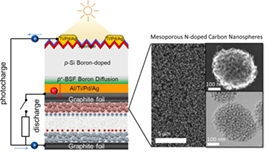News & Press
Generating, Converting and Storing Energy in a Compact System
Research team develops photosupercapacitor with integrated silicon solar cell

The novel electrode material is based on so-called Nitrogen-doped carbon nanospheres (MPNC), which are porous and thus have a large specific surface area. Source: Taisiia Berestok
Interconnected, intelligent devices and sensors – also known as the Internet of Things – are increasingly finding their way into households and industry facilities. Progress toward such miniaturized and automated devices requires the development of reliable energy sources that have a lower environmental impact and cost than conventional batteries. A solution could be photosupercapacitors that harvest solar energy, convert and store it and deliver electrical energy on demand in a single, compact system. Researchers from the Cluster of Excellence Living, Adaptive and Energy-autonomous Materials Systems (livMatS) at the University of Freiburg developed such a photosupercapacitor with an integrated silicon solar cell. The team around Dr. Taisiia Berestok, Prof. Dr. Anna Fischer, Prof. Dr. Stefan Glunz, and Christian Diestel published their results in the scientific journal Advanced Materials Technologies.
Three-electrode system ensures high overall energy
To date combined solar and storage systems are usually built in a modular fashion: A solar cell is wired to a separate electrochemical storage device, either a supercapacitor or a battery. A total of four electrodes are used – two for energy generation and two for storage. Such systems require complex wiring and take up a lot of space, which reduces the overall energy and power density.
In contrast, the integrated photosupercapacitor developed by the Freiburg research team requires only three electrodes, which is due to the fact that the solar cell and the supercapacitor share an electrode, that acts simultaneously as charge acceptor for the storage part. The supercapacitor used is based on a novel electrode material, so-called mesoporous Nitrogen-doped carbon nanospheres (MPNC). “They are porous and thus have a very large specific surface area and hence contact area at the interface of the electrolyte and the electrode where the light-generated charge carriers transferred from the solar cell are stored particularly well,” says Taisiia Berestok.
Environmentally friendly aqueous electrolytes reduce costs
Compared to other types of solar cells, silicon solar cells are characterized by their particular efficiency and robustness, which makes the resulting devices particularly durable. “The use of silicon solar cells also offers the advantage that we can use aqueous gel-like electrolytes,” says Berestok. “They are non-toxic, environmentally friendly and do not require special encapsulation within the system. That lowers costs and facilitates potential commercial application.”
Photosupercapacitor achieves efficiency of 11.8 percent
The silicon solar cell provides a comparatively fast charge of 0.6 volts in less than 5 seconds - even under low-light conditions paving the way towards energy autonomous indoor photostorage devices. The system achieves an efficiency of 11.8 percent, which exceeds the performance of previous supercapacitors with integrated silicon solar cells. “We are planning to extend the design approach for developing flexible photostorage devices with high working voltage and enhanced energy and power output,” says Berestok.
About the Cluster of Excellence livMatS
The vision of the Cluster of Excellence Living, Adaptive and Energy-autonomous Materials Systems (livMatS) is to combine the best of two worlds – nature and technology. livMatS develops life-like materials systems inspired by nature. These systems will adapt autonomously to their environment, harvest clean energy from it, and be insensitive to damage or recover from it.
Original publication:
Berestok, T., Diestel, C., Ortlieb, N., Glunz, S. W., & Fischer, A. (2022). A Monolithic Silicon‐Mesoporous Carbon Photosupercapacitor with High Overall Photoconversion Efficiency. Advanced Materials Technologies, 2200237. doi: 10.1002/admt.202200237
Contact:
Prof. Dr. Anna Fischer
Cluster of Excellence Living, Adaptive and Energy-autonomous Materials Systems (livMatS)
University of Freiburg
Email: anna.fischer@ac.uni-freiburg.de
Tel: 0761 203-8717
Dr. Taisiia Berestok
Cluster of Excellence Living, Adaptive and Energy-autonomous Materials Systems (livMatS)
University of Freiburg
Email: taisiia.berestok@livmats.uni-freiburg.de
Tel.: 0761/203-8717
Sonja Seidel
Science Communication
Cluster of Excellence Living, Adaptive and Energy-autonomous Materials Systems (livMatS)
University of Freiburg
Email: sonja.seidel@livmats.uni-freiburg.de
Tel.: 0761/203-95361
